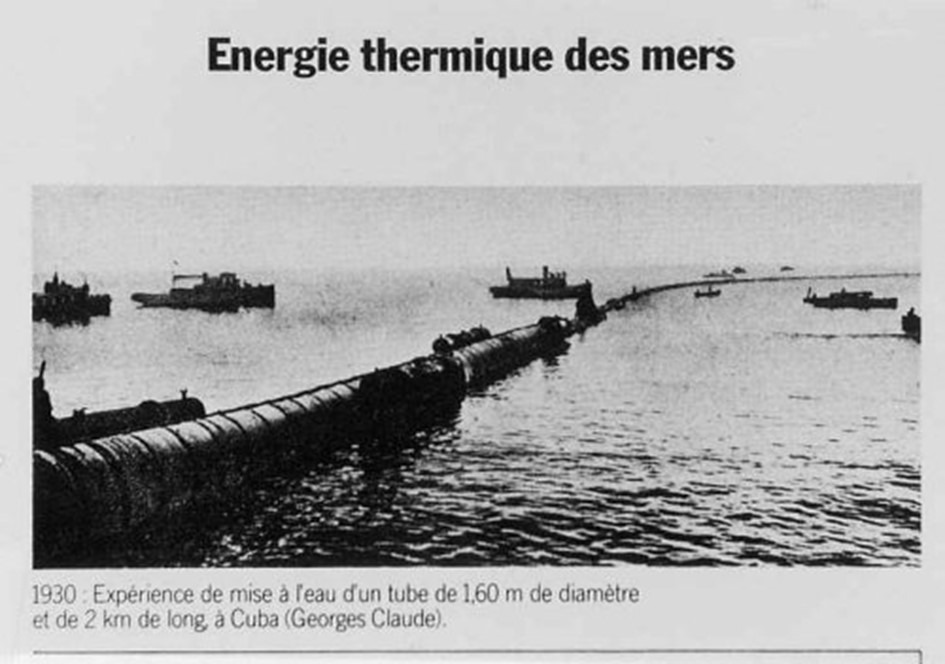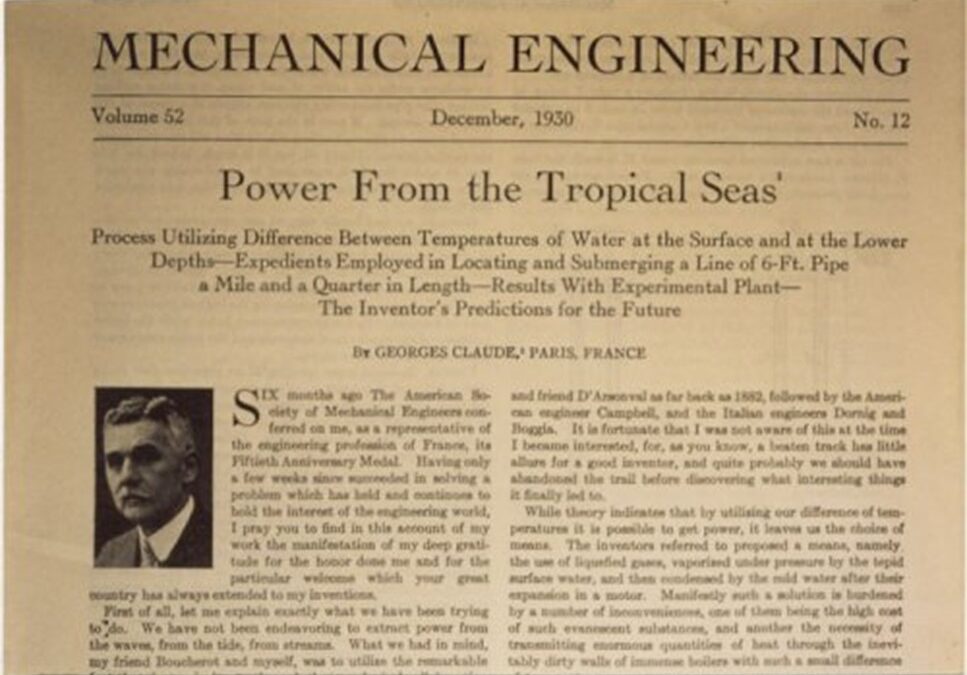Ocean Thermal Energy Conversion (OTEC) is a not-so-new groundbreaking technology that harnesses the temperature difference between the surface and deep ocean waters to generate electricity. This renewable energy source holds immense potential to provide clean and sustainable power for communities worldwide, notably those Small Island Developing States (SIDS) near the equator. This article will explore the science behind OTEC and why it is considered the future of island-based energy power.
Jacques Arsene d’Arsonval, the French polymath (physician, physicist, and inventor), first proposed the concept of OTEC in his 1881 paper titled “La Houille Blanche” or “The White Coal.” He envisioned utilizing the temperature gradient between warm surface water and cold deep water in the ocean to generate electricity. Over 125 years later, his vision is becoming a reality.
Fifty years later, his student, Georges Claude, built the first-ever working 22 kw OTEC installation in Cuba in 1930
Adopting ocean energy, including OTEC, is crucial in SIDS and Coastal (Least Developed Countries) LDCs. These countries import over 250 million barrels of petroleum yearly. They are 90% dependent on fossil fuel imports, highlighting the urgent need for alternative energy sources.
What is OTEC?

The operation of OTEC systems relies on three main components:
- a surface water intake,
- a heat exchanger, and
- a power generation system.
To understand how OTEC works, let’s consider the car engine analogy. In a car engine, fuel is burned to produce mechanical energy, which is then converted into rotational motion to power the vehicle. Similarly, in OTEC, warm surface water acts as the fuel, while cold deep water serves as the sink for heat rejection. The temperature difference between the two water sources drives a heat engine, which generates electricity through a turbine.
One of the critical advantages of OTEC is that it provides a constant and reliable energy source. Unlike solar or wind power, which depends on weather conditions, OTEC can operate 24/7, making it ideal for islands that often face energy challenges due to their remote locations. Additionally, OTEC systems have a long lifespan, reducing the need for frequent maintenance and replacement.
But how does OTEC contribute to Sustainability?

By harnessing the temperature gradient in the ocean, OTEC systems tap into an infinite and renewable energy source. They produce no greenhouse gas emissions, making them environmentally friendly and reducing the reliance on fossil fuels. OTEC also has the potential to address other sustainability challenges, such as desalination and aquaculture, by utilizing cold deep water for cooling or creating favorable conditions for marine life.
Several scientific studies have confirmed the viability and potential of OTEC as a sustainable energy solution.
According to the American Society of Mechanical Engineers, OTEC has the potential to produce electricity at competitive prices compared to fossil fuel-based power plants. It’s also environmentally friendly, with minimal impact on marine ecosystems and reducing greenhouse gas emissions. OTEC can enhance energy security for island communities by providing a reliable and sustainable source of electricity. Comprehensive studies also highlight the technology’s potential and its carbon reduction benefits. Assessing the economic viability and commercialization potential, researchers emphasize the need for policy support and market incentives.
Technology-Leading Global OTEC
Several companies are at the forefront of OTEC technology development. Global OTEC stands out as one of the key players in the field. The company has developed an innovative system that harnesses the power of the ocean and converts it into electricity using OTEC principles.
The benefits of ocean energy, especially OTEC, are numerous. It provides a sustainable and renewable power source, reducing dependence on fossil fuels and associated costs. The development of local economies is another advantage, as ocean energy technologies can create job opportunities and support economic growth. Furthermore, ocean energy helps mitigate climate change by reducing greenhouse gas emissions, making it an environmentally friendly choice. The potential for ocean energy systems to revolutionize the global energy industry cannot be overlooked.
The Future is Here

OTEC is a promising technology that has the potential to revolutionize island-based energy power. Its ability to provide constant and sustainable electricity and its environmental benefits make it a favorable choice for communities near the equator. With further investment, research, development, and policy support, OTEC can pave the way towards a cleaner and more sustainable future.
References
- D’Arsonval, J. A. (1881). La Houille Blanche.Ocean Energy Systems. (n.d.). Ocean Thermal Energy Conversion. Retrieved from https://www.ocean-energy-systems.org/technology/otec/
- Chen, Y., Xu, M., & Wang, H. (2019). Review of Ocean Thermal Energy Conversion (OTEC) and Its Applications. Energies, 12(23), 4475.
- Yan, J., Yang, M., & Wang, X. (2020). The Potential of Ocean Thermal Energy Conversion (OTEC) for Carbon-Free Power Generation. Energies, 13(6), 1505.
- Johnson, C., Gueymard, C., & Johnson, C. (2018). Ocean Thermal Energy Conversion: Assessing the Potential for Commercialization. Energies, 11(9), 2345.
- Barberis, Stefano, et al. “Techno-Economic Analysis of Multipurpose OTEC Power Plants.” E3S Web of Conferences, vol. 113, 2019, p. 03021, www.e3s-conferences.org/articles/e3sconf/pdf/2019/39/e3sconf_supehr18_03021.pdf, https://doi.org/10.1051/e3sconf/201911303021. Accessed 16 Oct. 2023.
The Global Ocean Energy Alliance (GLOEA)
recognizes the potential of OTEC and advocates for its adoption in Small Island Developing States (SIDS) and Coastal Least Developed Countries (LDCs). These countries heavily rely on fossil fuel imports, with 90% of their electricity-generating capacity powered by fossil fuels. Replacing this capacity with OTEC systems could reduce their dependence on imported fuels and save over $5 billion in fuel costs annually.
GLOEA Quick Facts
- GLOEA aims to replace fossil-fuel-powered electricity-generating plants in Small Island Developing States (SIDS) and Coastal Least Developed Countries (LDCs)
- SIDS and Coastal LDCs are 90% dependent on fossil fuel imports
- SIDS and Coastal LDCs import over 250 million barrels of petroleum yearly
- These countries need to replace 10,000 megawatts of electricity-generating capacity
- The replacement will save over $5 billion in fuel costs annually
- GLOEA ensures collective action to replace inefficient generators with Ocean Energy Systems
Visit the Global Ocean Energy Alliance (GLOEA) at https://gloea.org/technologies/otec/

